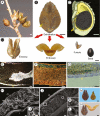A water drop-shaped slingshot in plants: geometry and mechanics in the explosive seed dispersal of Orixa japonica (Rutaceae)
- PMID: 33608717
- PMCID: PMC8103806
- DOI: 10.1093/aob/mcab017
A water drop-shaped slingshot in plants: geometry and mechanics in the explosive seed dispersal of Orixa japonica (Rutaceae)
Abstract
Background and aims: In angiosperms, many species disperse their seeds autonomously by rapid movement of the pericarp. The fruits of these species often have long rod- or long plate-shaped pericarps, which are suitable for ejecting seeds during fruit dehiscence by bending or coiling. However, here we show that fruit with a completely different shape can also rely on pericarp movement to disperse seeds explosively, as in Orixa japonica.
Methods: Fruit morphology was observed by hard tissue sectioning, scanning electron microscopy and micro-computed tomography, and the seed dispersal process was analysed using a high-speed camera. Comparisons were made of the geometric characteristics of pericarps before and after fruit dehiscence, and the mechanical process of pericarp movement was simulated with the aid of the finite element model.
Key results: During fruit dehydration, the water drop-shaped endocarp of O. japonica with sandwich structure produced two-way bending deformation and cracking, and its width increased more than three-fold before opening. Meanwhile the same shaped exocarp with uniform structure could only produce small passive deformation under relatively large external forces. The endocarp forced the exocarp to open by hygroscopic movement before seed launching, and the exocarp provided the acceleration for seed launching through a reaction force.
Conclusions: Two layers of water drop-shaped pericarp in O. japonica form a structure similar to a slingshot, which launches the seed at high speed during fruit dehiscence. The results suggest that plants with explosive seed dispersal appear to have a wide variety of fruit morphology, and through a combination of different external shapes and internal structures, they are able to move rapidly using many sophisticated mechanisms.
Keywords: Orixa japonica; Explosive seed dispersal; Rutaceae; geometry; mechanical simulation; multi-layered structure; plant movement.
© The Author(s) 2021. Published by Oxford University Press on behalf of the Annals of Botany Company. All rights reserved. For permissions, please e-mail: journals.permissions@oup.com.
Figures




Similar articles
-
"Phoenix in Flight": an unique fruit morphology ensures wind dispersal of seeds of the phoenix tree (Firmiana simplex (L.) W. Wight).BMC Plant Biol. 2022 Mar 12;22(1):113. doi: 10.1186/s12870-022-03494-z. BMC Plant Biol. 2022. PMID: 35279080 Free PMC article.
-
Functional packaging of seeds.New Phytol. 2021 Jun;230(6):2154-2163. doi: 10.1111/nph.17299. Epub 2021 Apr 3. New Phytol. 2021. PMID: 33629369 Free PMC article. Review.
-
Fruit fracture biomechanics and the release of Lepidium didymum pericarp-imposed mechanical dormancy by fungi.Nat Commun. 2017 Nov 30;8(1):1868. doi: 10.1038/s41467-017-02051-9. Nat Commun. 2017. PMID: 29192192 Free PMC article.
-
Growth and tension in explosive fruit.Curr Biol. 2024 Mar 11;34(5):1010-1022.e4. doi: 10.1016/j.cub.2024.01.059. Epub 2024 Feb 14. Curr Biol. 2024. PMID: 38359820
-
Insights into the microstructures of hygroscopic movement in plant seed dispersal.Plant Sci. 2014 Jun;223:124-33. doi: 10.1016/j.plantsci.2014.03.014. Epub 2014 Mar 22. Plant Sci. 2014. PMID: 24767122 Review.
References
-
- Armon S, Efrati E, Kupferman R, Sharon E. 2011. Geometry and mechanics in the opening of chiral seed pods. Science (New York, N.Y.) 333: 1726–1730. - PubMed
-
- Audoly B, Pomeau Y. 2010. Elasticity and geometry: from hair curl to the nonlinear behavior of shells. Oxford: Oxford University Press.
-
- Bar-On B, Sui X, Livanov K, et al. . 2014. Structural origins of morphing in plant tissues. Applied Physics Letters 105: 033703.
-
- Chen PY, McKittrick J, Meyers MA. 2012. Biological materials: Functional adaptations and bioinspired designs. Progress in Materials Science 57: 1492–1704.
-
- Day JS. 2000. Anatomy of capsule dehiscence in sesame varieties. The Journal of Agricultural Science 134: 45–53.
Publication types
MeSH terms
Substances
LinkOut - more resources
Full Text Sources
Other Literature Sources

